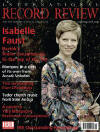Texte paru dans: / Appeared in:
*

International Record Review - (09//2013)
Pour
s'abonner / Subscription information
Ricercar
RIC335

5400439003354 (ID335)
Doulce Mémoire is named after a beautiful and hugely popular song by the French Renaissance composer Pierre Sandrin (c. 1490-after 1561). It is one of the leading groups today performing on Renaissance wind instruments such as recorders, cornetts, shawms , sackbutts and curtals (ancient bassoons). Its founder and director, Denis Raisin Dadre, is a scholar in this repertory as well as a first-rate performer on members of the recorder and bassoon families. The ensemble was hosted by the Naïve label for some years, producing several innovative and outstanding recordings, and has now found a new home on the Belgian Ricercar label.
When a song such as Doulce mémoire or a madrigal such as Cipriano de Rore’s Anchor che col partire became popular in the Renaissance, many other composers and performers would use it as the basis for a range of other musical forms, from highly embellished arrangements to full Mass settings based on the song’s melody. The ornamented versions could be sung, played on a solo instrument such as lute or harpsichord, performed by an instrumental ensemble, or by a combination of these forces. Some of these songs with ‘diminutions’ were fully composed and even published; others would have been largely improvised by the performers. This new recording by Doulce Mémoire plausibly combines those approaches.
Antonio de Cabezón (1510-66) was a blind organist employed by the Spanish royal family. He did not confine himself to liturgical music making but was a master at making extensive ornamented arrangements of secular songs from across Europe. These arrangements were collected and published two years after his death by his son, Hernando, who also included some of his own works. As well as many songs by composers such as Lassus, Clemens Non Papa, Crecquillon, Sandrin ( Doulce mémoire, of course) , Josquin, Verdelot and others, the collection also includes Antonio’s elaborated versions of plainchants, hymns and other types of sacred music. This recording, however, focuses exclusively on secular songs, including dance songs such as the catchy La Dama le demanda, which is known to churchgoers with the words ‘All Glory Praise and Honour’ . In many cases, the ensemble sensibly also performs a sung version, as many modern listeners will not be as familiar with the melodies as were their sixteenth-century forebears.
The ensemble cleverly weaves Cabezón’s instrumental diminutions around the vocal line, which is itself often embellished by the beautifully focused soprano Clara Coutouly. Despite the lack of any bowed strings such as gambas or Renaissance violins, there is enormous variety in timbre, colour and texture in the rich array of wind and plucked instruments. The various types of instrument are played as small consorts within their own ‘family’ and are not generally mixed; that is, the harp, spinet and lute or guitar are played together, as are the shawms and curtals, various members of the recorder family and, finally, there is an ‘alta capella’ — a common Renaissance grouping of cornett, shawms, curtals and trombone.
Anyone who has heard Renaissance wind instruments only in the hands of pioneers 40 or so years ago may shudder at the memory of the wheezy sounds they produced. Both performance standards and the quality of modetn copies of sixteenth-century instruments have improved enormously since then and programmes such as this can be enjoyed simply as highly sophisticated music-making, with no hint of well-meaning antiquarianism. Each member of Doulce Mémoire is an outstanding player of his or her respective instrument, or, in several cases, instruments. Playing each line of a polyphonic work with distinct, sometimes improvised, diminutions while not losing cohesion as an ensemble takes enormous skill and these musicians (and singer) bring it off triumphantly.
The recording was made in the refectory of the Abbaye de Fontevraud and is of demonstration quality. (I have been using it to show off the virtues of a new amplifier.) The founder of the Ricercar label, the indefatigable Jérôme Lejeune , contributes notes up to his usual high standards . All in all, this is a hugely enjoyable disc, which will appeal particularly to those already familiar with the songs that have been so cleverly arranged. It is, in fact, as good a disc of Renaissance secular music as I have heard.
Cliquez l'un ou l'autre
bouton pour découvrir bien d'autres critiques de CD
Click either button for many other reviews


